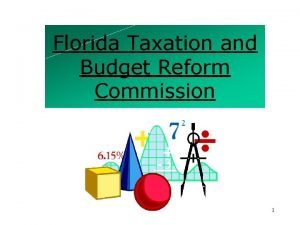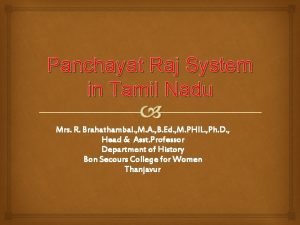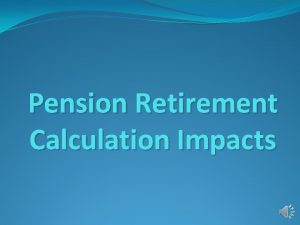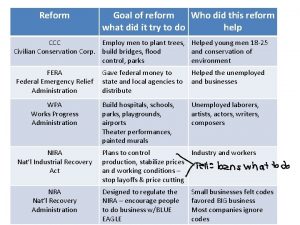ECCU PENSION REFORM RECOMMENDATIONS 1 PENSION REFORM COMMISSION
















- Slides: 16

ECCU PENSION REFORM RECOMMENDATIONS 1 PENSION REFORM COMMISSION

Order of Presentation 2 Why are Pensions Important? What are necessary to ensure Adequate Pensions? Make Your Money Work for You! Summary of Major Recommendations of the ECCU Pension Reform Commission Essential Structural Design Features of Tier Two and Three Schemes Recommendations on Operational Matters Details of The Four Tier Arrangement Implementation Issues Time Allocation of Income to the Four Tier Programme Why are Governments so Concerned About Pension Reform? Conclusions

Why Are Pensions Important? 3 Setting aside for the rainy day: practical and biblical (Genesis Ch. 41: 34 -36) Increasing life expectancy: from 69. 6 to 76. 1 by 2050 for Grenada Increasing dependency ratio ( number of workers to dependants): currently the ratio is 1 dependent to 2 workers but this is expected to move to two dependents per worker. Reduced dependence on children, family and society. Governments do not have the resources to take care of that need. Avoid/minimize poverty amongst senior citizens is an increasing responsibility of governments One of the most important sources of long term savings for economic development.

What are Necessary to Ensure Adequate Pensions? 4 Setting aside a fixed proportion of income to savings for retirement. Commencing from first employment and continuing diligently during working life Ensuring that the administrative cost of managing it is not too high. Ensuring that the managers get the best returns on your savings. Ensuring that the economy is well run so that you get real goods and not financial paper returns on your pensions. Need low inflation and a stable dollar.

Make Your Money Work For You (One dollar per day) 5 0% 3% (mattress) (savings) 5% (bonds) 8% (equities) 10% (own business) 10 years $3600 $4, 127 $4, 528 $5, 215 $5, 737 20 years $7200 $9, 673 $11, 904 $16, 474 $20, 619 30 years $10, 800 $17, 127 $23, 918 $40, 782 $59, 218 40 years $14, 400 $27, 144 $43, 876 $93, 445 $159, 297 50 years $18, 000 $40, 607 $98, 176 $206, 558 $419, 004

Summary of Commissioners’ Recommendations 6 Establish a four tier Social Assistance and Retirement Programme : Tier One: Social Assistance to the elderly and challenged Tier Two: Social Security or National insurance Tier Three: Supplementary Pension Schemes State Pension Schemes Private Occupational Pension Schemes Tier Four: Voluntary Savings Programmes Savings for Higher Education, Residential Housing, Investment, Reverse Mortgages Establish a government department to take care of the needs of the elderly.

Essential Structural Design Features of Tier Two and Three Schemes 7 Adequacy, of the objectives and of the provisions to meet these objectives Affordability, to the beneficiaries of the Schemes provisions and costs Sustainability, of the Scheme to deliver its provisions and promises to all its beneficiaries and stakeholders. Robustness, to withstand the inherent vulnerabilities and possible associated fluctuations that the Schemes would inevitably face. Equitability and fairness, such that the members’ benefits are transparent and based on their relative contributions to the Schemes and subject only to natural randomness. It should not be used, or seen to be used, as a policy instrument for social and/or political engineering. Predictability, to deliver on the promises, whatever their longevity, without surprises, bearing in mind that the arrangement is over a long time spanning many generations

Recommendations on Operational Matters 8 Use regional arrangements wherever it is possible to do so to gain economies of scale, risk diversification, minimize political interference, and enhance returns on investments National and regional schemes can and should run side by side to give governments an option and also to highlight the better performance of regional arrangements All tier Two and Three Schemes must be: Contributory in equal proportions between employer and employee Contributed to from first employment and continuing to final employment Portable between employer and country Immediately and fully vested in beneficiaries Integrated so that the combined benefits from both can provide a pension of up to 85% of final salary. As standardized and uniform as possible to create better public understanding and to facilitate and reduce administration costs. Based on a standard retirement age for all employment and to provide an average retirement period of 15 years.

Details of the Four Tier Arrangement: Pillar One = Social Assistance 9 For financial support and/or care to the indigent elderly to bring income to an affordable level between the indigent and poverty lines. To provide skills training to the indigent and unemployed of working age to obtain employment at least to the level of the minimum wage. To provide income support to the other indigents to an affordable level between the indigent and poverty lines. Funding for this to come from an annual 2. 5% allocation from revenue and from fiscal incentives provided to social groups and the corporate sectors to sponsor homes for the elderly. Managed by either National Insurance and/or a designated government department

Details of the Four Tier Arrangement: Pillar Two = National Insurance 10 To ensure a basic post retirement income that is reflective of years of service and contribution levels to a maximum that is related to a percentage of per capita income. To provide some income support to contributors who experience sudden interruptions in employment earnings and to partially cover them for 5 months of unemployment and on a reducing basis during a maximum 6 month period. Compulsory equal 5% contribution from employer and employee and 10% for self employed. Defined benefit scheme with national and regional portability and managed by National Insurance. Could be run as either a national or regional schemes with the latter being the much superior option.

Details of the Four Tier Arrangement: Tier Three = Supplemental Pension Plans 11 Integrated with National Insurance to bring combined retirement income to between 75% to 85% of “final income” Defined Contribution arrangement Equal contribution of 5% from employer and employee and 10% from self employed. Applicable and continuing from first employment to retirement. Public sector employers in regional and/or national State Pension arrangement. Private sector employees would participate in strongly closely regulated specialised financial institutions operating at both national and regional levels. Both schemes would have virtually identical features to allow free transferability between public and private sectors and among countries.

Details of the Four Tier Arrangement: Tier Four = Household Savings and Investment 12 Private Savings and Investment Optional but essential To meet individuals and household need for savings for home ownership, further education of self and dependants, speculative investments, precautionary balances A 25% of income if properly timed and commencing from first pay and continuing should meet these investment goals. Needs professional and objective regulation, close monitoring and strong penal sanctions for compliance failures. Reverse Residential Mortgages Essentially this is voluntary dissaving by converting owners’ equity in a home into a lump sum and/or income stream for providing income during retirement while enjoying accommodation for life and without having to repay the encashed equity. Needs careful regulation, possible counselling and close monitoring.

Implementation Issues 13 Terminal benefits (pensions and gratuities) are costly and are currently costing the GOG about 5. 8% of its revenue. Our proposals when fully settled should cost no more than 4. 0% of revenue Recommended proposals with pension for all will ultimately eliminate expensive gratuities. For cost purposes the recommendations on Tier three arrangements do not make provisions for retroactivity. When accepted it will be a new arrangement that will apply mainly to new entrants. Certain persons under existing programmes may be able to convert their benefits under existing arrangements to the much improved benefits of the proposed arrangement but it would not be on a one to one basis.

Time Allocation of Income to the Four Tier Programme 14 18 to 30 years 31 to 45 years 46 To 65 years Compulsory Savings 10% 10% Employer contribution 10% 10% Voluntary Savings 25% 25% TOTAL 45% 45% Social Security 10% 10% Supplementary Pension 10% 10% Housing 10% 15% 7. 5% Higher Education 10% 5% 12. 5% Taxes 5% 5% 5% Sources Uses

Why Are Governments So Concerned About Pension Reform? 15 Alleviate or minimize poverty among population and particularly among senior citizen who are becoming the largest group in the society Substantial source of savings for long term economic development. Broadens and deepens the financial and capital markets If pension arrangements are not properly managed it could lead to considerable distress for senior citizens (CLICO and BAICO). Minimizes the need for government assistance to the elderly and makes more government funds available for other essential social and economic physical and institutional infrastructural programmes.

Conclusions 16 The need for a well structured social assistance and cost effective contributory retirement programmes are imperatives given the emerging patterns and structures of our demography, society, economy and the heavy demands on government for virtually everything, while there is an aversion to paying taxes. Participation must be compulsory for all commencing from first employment right through to retirement. Regional management arrangements are superior to national efforts. THANK YOU.
 Commuted pension vs uncommuted pension
Commuted pension vs uncommuted pension Principles of curriculum construction
Principles of curriculum construction Recommendation of kothari commission on teacher education
Recommendation of kothari commission on teacher education Taxation and budget reform commission
Taxation and budget reform commission Sections 1-6 1-7 commission and graduated commission
Sections 1-6 1-7 commission and graduated commission Nap 6 recommendations
Nap 6 recommendations Npe 1986 12 parts
Npe 1986 12 parts Giving opinions en español
Giving opinions en español Self control images
Self control images What is spms in government
What is spms in government J.j. irani committee report
J.j. irani committee report Balwant rai committee
Balwant rai committee Swgdrug
Swgdrug Oem recommendations
Oem recommendations Towards deep conversational recommendations
Towards deep conversational recommendations Nap 6 recommendations
Nap 6 recommendations Omniture click map
Omniture click map































